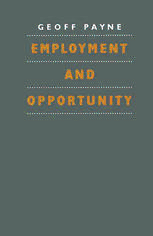
Employment and Opportunity PDF
Preview Employment and Opportunity
EMPLOYMENT AND OPPORTUNITY By the same author SOCIOLOGY AND SOCIAL RESEARCH MOBILITY AND CHANGE IN MODERN SOCIETY Employment and Opportunity Geoff Payne Dean, Faculty of Social Science Plymouth Polytechnic M © Geoff Payne 1987 All rights reserved. No reproduction, copy or transmission of this publication may be made without written permission. No paragraph of this publication may be reproduced, copied or transmitted save with written permission or in accordance with the provisions of the Copyright Act 1956 (as amended). Any person who does any unauthorised act in relation to this publication may be liable to criminal prosecution and civil claims for damages. First published 1987 Published by THE MACMILLAN PRESS LTD Houndmills, Basingstoke, Hampshire RG21 2XS and London Companies and representatives throughout the world British Library Cataloguing in Publication Data Payne, Geoff Employment and opportunity. 1. Social mobility-Great Britain I. Title 331.12'7941 HD5717.5.G7 ISBN 978-0-333-41828-4 ISBN 978-1-349-18555-9 (eBook) DOI 10.1007/978-1-349-18555-9 To Evan Contents List of Figures viii List of Tables ix Preface xi 1 Occupations and Mobility 1 2 The Historical and Social Context of Mobility 8 3 The Occupational Structure 35 4 Occupational Fluidity and Class Structure 60 5 Trends in Occupational Mobility 91 6 Education and Mobility 122 7 Careers, Cohorts and Classes 155 8 Mobility and Social Class 189 Appendix: Methodological Details 193 Notes 198 Bibliography 199 Author Index 206 Subject Index 208 vii List of Figures 2.1 Population per 10 km square: a bird's eye view 13 3.1 Changes in highly skilled non-farm occupations, 1921-71 40 3.2 Changes in low-skilled non-farm occupations, 1921-71 44 3.3 Changes in intermediate-skilled non-farm occupations, 1921-71 49 3.4 Changes in farm occupations in Scotland, 1921-71 52 4.1 Distribution of origins and destination to scale 64 5.1 Diagrammatic representation of factors in changing mobility rates 92 5.2 Five-year moving averages for non-manual employment and mobility on first entry to labour market 95 5.3 Five-year moving averages for non-manual employment and mobility, ten years after entry to labour market 97 5.4 Percentage sample in each of the four classes 102 5.5 Percentage of each non-manual class recruited from manual origins 104 5.6 Percentage of total upward mobility distributed among four classes 106 5.7 Mobility factors 107 5.8 Proportions of upward mobility in industrial sectors 108 6.1 Diagrammatic representation of education and occupa- tions 135 7.1 Direct and indirect entry to non-manual work 159 7.2 Moving averages for five-year cohorts: proportions entering skilled and less skilled manual first jobs 173 7.3 Moving averages for five-year cohorts: career mobility from skilled manual first job 174 7.4 Moving averages for five-year cohorts: career mobility from semi-skilled or unskilled manual first jobs 176 7.5 Moving averages for five-year cohorts: career mobility from lower range non-manual first jobs 177 7.6 Moving averages for five-year cohorts: career mobility from skilled manual first job 178 viii List of Tables 2.1 Performance of four British industries 19 2.2 A comparison of the industrial bases of male employ- ment in Scotland and England and Wales, 1921 and 1971 26 2.3 Industrial base, Scotland 1921, 1951, 1961, 1971 (exclud- ing out of work)- male jobs 27 2.4 Main sectoral changes 28 3.1 Highly skilled non-farm workers (SEG 1-5) in Scotland, ~~ ~ 3.2 Non-farm manual workers (SEGs 7, 9, 10 and 11) in Scotland, by sex 43 3.3 Intermediate non-farm workers (SEGs 6, 8 and 12) in Scotland, by sex 48 3.4 Farm occupations (SEGs 13, 14 and 15) in Scotland, by sex 51 3.5 Shift/share analysis of occupational change: Scottish males, 1961-71 54 3.6 Deviations between observed and expected frequencies in Scottish SEGs 56 4.1 Intergenerational male mobility: numbers and percen- tage inflow 65 4.2 Proportions of mobility associated with classes 66 4.3 Intergenerational outflow mobility 72 5.1 Sectoral share of upward mobility, 1930-9 and 1960-9 117 5.2 Intra-sectoral changes, 1930-9 and 1960-9 119 6.1 Type of secondary schooling 129 6.2 Type of secondary schooling and social mobility of men born into UMC families 130 6.3 Destination of those with UMC origins by educational success 131 6.4 Type of secondary schooling: inflows 132 6.5 Inflow to UMC by level of educational qualifications 133 6.6 Types of schooling of elite groups in various studies 139 6.7 Proportion of upmobiles: men intergenerationally mobile from manual origins to non-manual destinations who had 'high qualifications' 144 6.8 Proportions of mobile groups with 'high qualifications' 145 ix X List of Tables 6.9 Percentage correct predictions of association between qualifications and occupational status on the basis of the tightening link hypothesis 147 6.10 Inter-industry variations in prediction rate(%) of the tightening link thesis 149 6.11 Inter-industry variation in prediction rate of the tighten- ing link 150 7.1 Goldthorpe's data on counterbalance: outflow percen- tages 157 7.2 Direct and indirect entry to manual and non-manual classes 159 7.3 Direct and indirect entry to non-manual occupations in four cohorts 160 7.4 Percentage gross mobility/immobility, non-manual occupational destinations 162 7.5 Entry to non-manual employment by origin class: five industrial sectors 166 7.6 Access to non-manual occupations by cohort, sector and origin class 168 7. 7 Mobility between first and present job for adult males born 1909-48 184 7.8 Number of previous jobs by current industrial sector 185 A.1 The Scottish Mobility Study class schema 195
